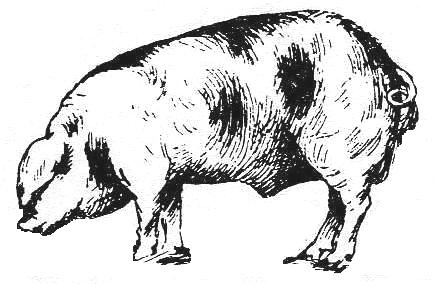Roast pork with herb crust & onion gravy
As Bill Neal and britishfoodinamerica have noted, British foodways have an ancient and continuing influence in the kitchens of the American south, even though most southern cooks would be surprised to learn that they use traditional British technique. This recipe adapted from Neal’s Southern Cooking (Chapel Hill 1989) covers the pork with a classic British spice paste, as he explains:
“A paste was often employed by English cooks who mastered fine roasting of large cuts and loints of meat. Southern cooks inherited the method and, typically, provided a more piquant seasoning.” (Southern Cooking 98)
For all his considerable strengths as a historian and cook, in this instance Neal has succumbed to one of the many false myths about British food, that it traditionally must be underseasoned. As Elizabeth David demonstrates in Spices, Salt and Aromatics in the English Kitchen, however, the British fondness for highly spiced dishes predates the foundation of its North American and Caribbean colonies; one author has called cayenne ‘the pungent taste of empire.’
In practice, we found that Neal himself underseasoned his recipe by the standard of British tradition.
The onion gravy laced with sherry is a ubiquitous accompaniment for pork throughout the British archipelago (a diplomatic means of properly including Ireland in the mix).
While the spicing and technique employed in this recipe reflect the British tradition, we have not encountered this particular preparation elsewhere, so readers should consider the genesis of this dish all Neal’s, even in our modified version.
For the roast:
 -4 lb pork shoulder, scored diagonally with one-inch diamonds about ½ inch deep
-4 lb pork shoulder, scored diagonally with one-inch diamonds about ½ inch deep
-2 cups onions sliced into thin crescents
-2 Tablespoons lard
-2 Tablespoons unsalted butter
-1 teaspoon smashed and minced garlic
-½ cup flour
-½ teaspoon powdered bay
-generous ½ teaspoon or more cayenne
-2 teaspoons dry mustard
-1 teaspoon rubbed sage
-2 teaspoons dried thyme
-½ teaspoon sugar
-1 ½ teaspoons salt
-1 teaspoon pepper
-½ cup pork or chicken stock or water
For its gravy:
-another 2 cups pork or chicken stock, or water
-1 teaspoon Kitchen Bouquet
-2 teaspoons cornstarch
-2 oz dry to medium dry sherry (we like Amontillado here)
-salt and pepper
- Scatter the onions around a shallow metal roasting pan and place the pork on them.
- Make a roux by melting the lard and butter in a heavy skillet over low heat, stir in the garlic and cook it for a minute or two before adding the flour.
- Whisk the flour constantly until it barely begins to color, about 3-4 minutes, then whisk all the seasonings into the roux and immediately remove it from the heat so that it does not burn.
- Let the spiced paste cool, then smear it over the pork, pushing the paste down into the scored cuts. Let the meat stand at room temperature for at least 2 hours.
Preheat the oven to 475° - Pour the ½ cup of stock beneath the pork, put the pan into the oven and reduce the temperature to 325°.
- Cook the roast until it is done to your liking or until its internal temperature reaches about 160° to 165°, usually about 2 hours.
- Remove the pork from the pan and let it rest for at least 15 minutes while you make the gravy.
- Pour all the liquid and debris from the roasting pan into a heavy skillet and deglaze the pan with a little of the stock if necessary to loosen all of the browned particles.
- Add the remaining stock to the skillet with the Kitchen Bouquet.
- Whisk the cornstarch into the sherry, then take about ½ cup of the stock from the skillet and whisk it, too, into the sherry and cornstarch mixture.
- Stir the sherry mixture into the skillet, bring the gravy to a boil and reduce the heat to a simmer until it thickens, about 10 minutes. Check the seasoning and serve the gravy hot with thick slices of pork.
Notes:
- Neal uses pork loin, but unless you can get ahold of one of the excellent heritage breeds of pork, like Berkeley or Tamworth, modern pork loin is too lean to roast; it dries out before it is done.
- He also instructs his reader to baste the pork at half hour intervals: We found basting both unnecessary and undesirable. The shoulder is fatty enough to stay moist on its own, and spooning liquid over the paste made it mucky instead of allowing it to crisp.
- A shallow pan allows the heat to bombard the roast and helps the paste to form a tasty crust.
- We have increased the seasoning in the original recipe to conform to traditional British practice and replaced Neal’s dried red pepper flakes with the more traditional British cayenne. The flakes taste unduly harsh to us and create uneven hot spots in the gravy.
- The Kitchen Bouquet is, strictly speaking, optional, but we find it particularly helpful here.
- We have abandoned our usual predilection for undercooked meat in this recipe; there is something irresistibly succulent about the well-cooked pork that results from roasting in the flavorful paste. Neal goes a little further than we do, calling for an internal recipe of 170°. All these choices legitimately are yours.
- In the south, grits invariably would accompany this roast. Mashed potatoes are more traditionally British and equally good, but oatmeal and onion pudding which, Elisabeth Ayrton tells us, traditionally was served with pork or goose, may be even better. Mrs. Ayrton identifies it as generic “savoury pudding,” which is unhelpful for purposes of retrieval from her excellent Cookery of England (London 1974); otherwise her recipe is faultless.

